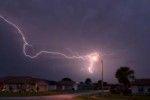Every flash of lightning within 100 km of downtown Houston will now be accounted for and easily accessible by anyone connected to the Internet.
Lightning data from Houston has been recorded with the Lightning Mapping Array system since Richard Orville, professor of atmospheric sciences at Texas A&M, and his graduate students installed it back in 2004, but the system received an upgrade in June. This upgrade included replacing the sensors’ wired power system with solar panels and adding a wireless delivery system that allows upload of data via Wi-Fi to Orville’s weather center in his office as well as to a website that anyone can access.
The system’s accuracy at detecting inner-cloud and cloud-to-ground lightning activity has increased from about 95 percent to
100 percent.
“We purchased and installed the system in 2004 with the support of grants from the National Science Foundation,” Orville said. “The equipment didn’t work very well because there was no reliable power source and the data was transmitted over phone lines. Last April, we received additional funding to upgrade and improve the system. The new system is reliable and currently the best running network.”
Matt Cullen, former graduate student of Orville and current employee of the National Weather Service in Portland, Oregon, said the upgrades improved the quality of the data.
“The solar panels can be located farther away from the sensors, which ensures that they don’t interfere with the readings and therefore create more accurate data,” he said. “Plus, Texas receives so much sunlight that it makes sense to have solar panels for our energy source. We also had problems with Internet connection, but the new cellular data modems are much more reliable and efficient compared to landlines.”
Orville said the LMA information was used for two main purposes: academic advancements and public safety. The data provides great research opportunities for students and will help them understand more about lightning.
“The research application is the first and foremost aspect [of the LMA],” Cullen said. It allows us to map the lightning in three dimensions and learn from it. We also share the data with the National Weather Service. Secondly, it is a public safety tool to help everyone since anyone can access the data and use it as a decision support tool such as whether or not to close down a pool. The research comes first, but public safety is something I’m passionate about. It can forecast lightning ground strikes that can save lives and prevent injuries.”
Cullen also talked about the analysis of the data and how the new upgrades had been working so far.
“We have established an effective range of 75 to 100 km with the center being just northwest of downtown Houston,” he said. “Because of the two sensors outside of Houston, with one in College Station and one in Galveston, we are able to get data from both of those cities as well. We’re very pleased with how well the network has been doing and the quality of the data we are receiving. It’s better than we expected. Problems usually crop up, but we have been very fortunate.”
Orville said Houston was chosen because its heat and humidity attracts lightning strikes. Gulf coast locations are particularly prone to lightning strikes, with Florida claiming the national title.
“Houston is the fourth-largest city in the U.S. and has the most lightning strikes in Texas,” Orville said. “Three to four people die and 10 to 20 people are injured from lightning strikes each year. The system detects where lightning is occurring right now and can inform people about the direction and movement of the storm based on past readings. Many people participating in outdoor activities such athletic departments would benefit from using the system.”
Hannah Alger, junior wildlife and fisheries major and resident of Houston, commented on the system, saying it would be a great tool for keeping people safe from lightning strikes.
“Knowing where lightning may strike is extremely useful especially in regards to sports and outdoor activities,” Alger said. “This makes [the system] very useful especially for safety and emergency awareness in an area like Houston.”
Orville said he uses the network (lightning.nmt.edu/hstnlma) daily by checking it before he takes his dog on a walk so that he doesn’t get caught in a thunderstorm.
Updated tech leaves no flash undetected
July 17, 2013

Donate to The Battalion
Your donation will support the student journalists of Texas A&M University - College Station. Your contribution will allow us to purchase equipment and cover our annual website hosting costs.



















